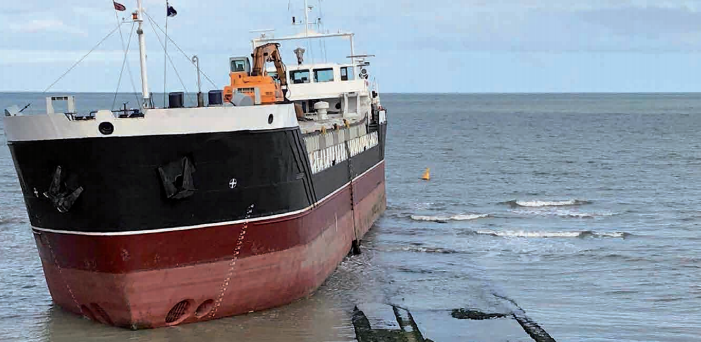In its latest Safety Digest, UK MAIB described a case of ship grounding in low tidal conditions, noting that, in exposed anchorages prone to tidal streams, a ship can remain safely at anchor only as long as there is sufficient scope on the cable and the anchor continues to hold.
The incident
In preparation for a short coastal passage, a small general cargo ship left its berth, in ballast, and proceeded to an anchorage approximately 1½nm offshore to layover for a few hours. Although the master was new to the ship, he was familiar with the area and had used the anchorage before.
It was slack water and, as he had done with his previous ship, the master anchored using 3 shackles of anchor cable. He then handed over the bridge watch to the chief officer at around midnight.
The chief officer spent his time completing chart corrections and did not monitor the ship’s position. As the tidal stream increased, the ship began to drag its anchor towards the north-west.
A little over 2 hours later, the ship was almost aground on a sandbank. The impending danger was spotted by a local Vessel Traffic Services operator (VTSO), who called the ship via VHF radio.
After being alerted to the situation, the chief officer called for the assistance of two ABs and the ship’s engineer to weigh anchor and move the ship into safer water. After the engine was started and the anchor recovered, the chief officer navigated the ship into deeper water to the south. He was navigating by eye, occasionally putting a fix on the chart and communicating with his crew and VTS.
As the ship continued to head to the south, the VTSO soon became concerned that it was closing the shore, and repeatedly advised the chief officer to alter course. However, although the chief officer acknowledged the VTSO’s warnings, he took no action.
It was dark, and the chief officer had become overwhelmed by the situation and had lost track of the ship’s position. The ship grounded at a speed of 7kts on a falling tide and remained high and dry for 12 hours.
Lessons learned
- In exposed anchorages prone to high winds or strong tidal streams, a ship can remain safely at anchor only as long as there is sufficient scope on the cable and the anchor continues to hold. Therefore, deciding how much cable to use has to be based on the actual and forecast weather conditions, and the predicted tidal stream and tidal range; not simply on what has worked before. Anchoring is definitely not a one size fits all operation.
- An anchor watch is inevitably quieter than a navigational watch underway and it is tempting to use the time to get on with other jobs. However, it is not a time to take your eye completely off the ball as a ship’s position needs to be checked regularly to make sure that the anchor is not dragging. If the GPS or ECDIS has an anchor watch facility, this should also be set.
- If dragging is detected or suspected, bridge watchkeepers may have to take immediate action themselves. Depending on the proximity of dangers, bringing the engine to immediate notice, preparing to let out more cable, letting go the second anchor, or weighing anchor, are all appropriate responses to bear in mind. However, although the initiation of immediate actions might be warranted, calling the master cannot be overlooked. Don’t be tempted to go it alone, otherwise the benefit of the master’s knowledge, experience and a second pair of hands to share the workload is lost.






























































